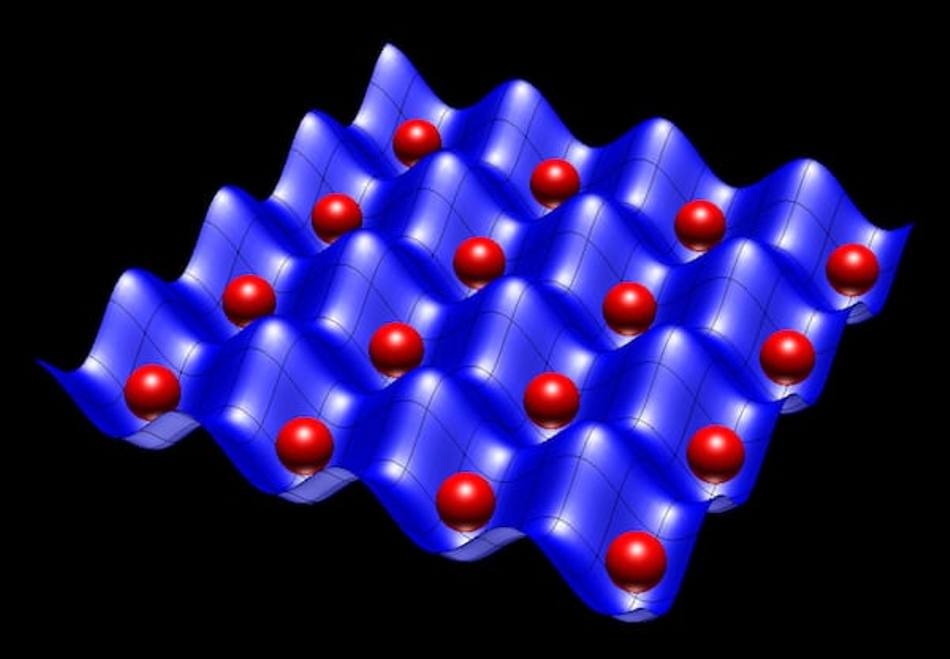Aug 23 2018
A computer scientist from Rice University and his team have put forward a technique for speeding up and simplifying the imposing challenge of diagnosing quantum computers.
 An illustration shows rubidium atom qubits isolated by scientists at the National Institute of Standards and Technology and proposed for use in quantum computers. A team led by Rice University computer scientist Anastasios Kyrillidis has proposed a scalable algorithm to significantly accelerate the task of validating the accuracy of quantum computers. (Image credit: NIST)
An illustration shows rubidium atom qubits isolated by scientists at the National Institute of Standards and Technology and proposed for use in quantum computers. A team led by Rice University computer scientist Anastasios Kyrillidis has proposed a scalable algorithm to significantly accelerate the task of validating the accuracy of quantum computers. (Image credit: NIST)
Anastasios Kyrillidis, an assistant professor of computer science who joined Rice this year, headed the development of a non-traditional technique as a diagnostic tool for robust, next-generation computers that are based on the spooky actions of quantum bits, or qubits, which are switches operating under rules that vary from the 0s and 1s in classical computers.
Quantum computers use the principles of quantum mechanics to rapidly solve challenging problems that would need more time to be solved on traditional supercomputers. They guarantee future advancements in cryptography, drug design, artificial intelligence, and advanced materials.
An open-access paper by Kyrillidis and his colleagues appears in the Nature journal Quantum Information.
Kyrillidis stated that similar to any new hardware, quantum computer systems are vulnerable to bugs that have to be squashed. This mandates continuous testing for validating their potentials. The absolute complexity of quantum computers that perform exponentially more with every bit needs an enormous amount of validation, he stated.
The focus of Kyrillidis’ technique is on quantum state tomography, a process based on medical tomography in which the images of a body are captured in slices that are reassembled after some time into a 3D map. He stated that quantum state tomography is different as it captures “images” of the state of the qubits of a quantum computer.
When a quantum computer executes an algorithm, it starts at a specific state; think of it as the input to the algorithm. As the computer progresses through steps of the algorithm, it’s going through many states. The state at the very end is the answer to your algorithm’s question.
Anastasios Kyrillidis, Assistant Professor of Computer Science
Kyrillidis stated the hardware or software errors that might have led to the computer to deliver unexpected results can be later identified by reassembling the full state from these measurements.
He told this involves taking a lot of measurements and that the computational cost of reconstruction could be high, even in the case of classical computers. Analysis of quantum computers using tomography with even only five or six qubits would be restrictive without somehow simplifying the task - and sophisticated machines have 50 qubits or more.
In a quantum computer, qubits are the basic units of information. Similar to a bit in a classical computer, each qubit can represent either 0 or 1. In contrast to a bit, a qubit can also simultaneously represent 0 and 1, a state known as superposition that exponentially increases the number of calculations that can be carried out by an array of qubits at an instant. Interestingly, the state of the qubit as determined by electron spin or magnetic polarization only exists if it is measured.
Kyrillidis stated that a computer’s power is drastically increased with even the slightest increase in the number of qubits.
In a system with five qubits, the state can be represented by a 2-to-the-5 times 2-to-the-5 matrix, so it’s a 32-by-32 matrix. That’s not big. But in a 20-qubit system like the one at IBM, the state can be characterized by a million-by-million matrix. If we were taking full measurements with regular tomography techniques, we would need to poll the system roughly a million-squared times in order to get enough information to recover its state.
Anastasios Kyrillidis, Assistant Professor of Computer Science
Kyrillidis and his colleagues solved the validation issue using an algorithm known as Projected Factored Gradient Decent (ProjFGD). It makes the most of compressed sensing, a technique that involves reducing the amount of incoming data while guaranteeing accurate results. He said the technique would reduce the number of measurements for a 20-qubit system to only about a million. “That’s still a big number, but much smaller than a million squared,” he said.
Kyrillidis said that IBM, where he was a research scientist for a year before coming to Rice, has put a quantum computer in the cloud where anyone can access it and run programs. He noted the company’s emphasis that if people learn more about programming for quantum computers, their skills will be more mature when the platform comes of age. However, there is an added advantage for him since it gives him a ready platform to test ProjFGD.
“The quantum state tomography tool is generic, and has more to do with the nature of the qubit rather than the specific architecture,” stated Kyrillidis. “As quantum computers get more powerful, it can definitely be scaled up to certify systems.”
The co-authors of the study are Amir Kalev of the University of Maryland, Dohyung Park of Facebook, Srinadh Bhojanapalli of the Toyota Technological Institute at Chicago, and Constantine Caramanis and Sujay Sanghavi of the University of Texas at Austin.
The study was supported by an IBM Goldstine Fellowship and the Department of Defense.